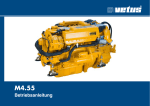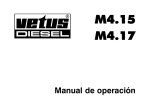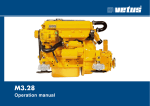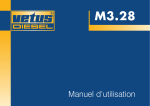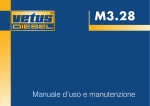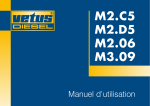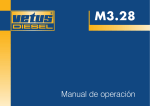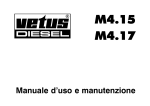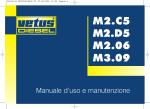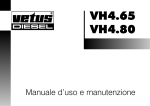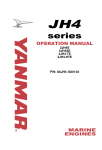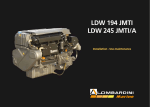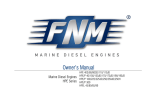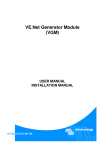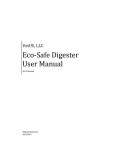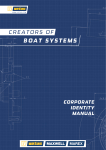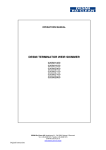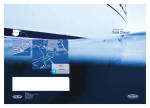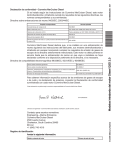Download 4 Maintenance
Transcript
M4.55 Operation manual M4.55 Operation manual Serial numbers Engine serial number Vetus: Mitsubishi: Gearbox serial number: 340402.01 Please enter the serial numbers here. These numbers should be quoted when inquiring about Customer Service, Repairs or Spare Parts (see page 6). We reserve the right to make any changes without previous notice. Copyright © 2007 Vetus N.V. Schiedam Holland Please read and observe the information given in this operation manual. This will enable you to avoid accidents, preserve the manufacturer’s warranty and maintain the engine in peak operating condition. For the Guarantee Conditions, see the Vetus Diesel 'Service and Warrantee Manual' (320199.05). This engine has been built exclusively for the application specified in the scope of supply and is to be used only for the intended purpose. Any use exceeding that scope is considered to be contrary to the intended purpose. The manufacturer will not not assume responsibility for any damage resulting therefrom. The risks involved are to be borne by the user. Use in accordance with the intended purpose also implies compliance with the conditions laid down by the manufacturer for operation, maintenance and servicing. The engine should only be operated, maintained and serviced by persons which are familiar with the former and the hazards involved. The relevant accident prevention guide- lines and other generally accepted safety and industrial hygiene regulations must be observed. Unauthorized engine modifications will invalidate any liability claims against the manufacturer for resultant damage. Manipulations of the injection and regulating system may also influence the performance of the engine, and its emissions. Adherence to legislation on pollution cannot be guaranteed under such conditions. Contents 1 Safety measures 4 Checking the coolant level 33 Checking and cleaning the 2 Introduction 9 raw water strainer Checking engine rpm 59 Cleaning the heat exchanger 60 34 5 Winter storage procedure 64 Data tag10 Draining water from the water Serial number10 separator/fuel filter 35 Cylinder numbering11 (Bleeding) 36 Fuel pump seal11 Changing the oil 37 6 Recommissioning after winter storage 67 Identification of engine parts12 Battery, cables and cable Control panels14 connections 40 7 Troubleshooting 72 8 Technical Data 80 Checking the gearbox oil level 42 3 Use Changing the gearbox oil 43 General guidelines17 Checking valve clearance 46 First commissioning18 Replacing the fuel filter 48 9 Operating media Running-in 21 Cleaning fuel lift pump 49 Fuel 83 Starting 22 Checking the V-belt 50 Lubrication Oil 85 Pre-heating 23 Checking flexible engine mounts51 Coolant 87 Cruising 26 Checking hose connections 51 Stopping 28 Checking fastenings 51 10 Wiring Diagrams 88 11 Overall Dimensions 94 12 Index 95 Checking the raw water pump 52 4 Maintenance Coolant replacement 54 29 Changing the air filter 58 Maintenance schedule 30 Checking the starter motor 58 Checking the oil level 32 Checking the alternator 58 Introduction 1 Safety measures Warning indications Warning indications The following warning indications are used in this manual in the context of safety: Danger Indicates that great potential danger exists that can lead to serious injury or death. Warning Indicates that a potential danger that can lead to injury exists. Caution Indicates that the usage procedures, actions etc. concerned can result in serious damage to or destruction of the engine. Some CAUTION indications also advise that a potential danger exists that can lead to serious injury or death. Note Emphasises important procedures, circumstances etc. Symbols Indicates that the relevant procedure must be carried out. Indicates that a particular action is forbidden. Pass the safety precautions on to other people who will use the engine. General rules and laws concerning safety and accident prevention must always be observed. Preventing fire and explosion 1 Safety measures Fire risk! • Do not smoke if refuelling. • Avoid spilling fuel on hot surfaces. Spilled fuel must be cleaned up immediately. • Do not use petrol or diesel to clean components but make use of good quality, non-inflammable, non-poisonous solvents that are available from dealers. • Always be alert to possible fuel or oil leakage! If you discover a leak, take countermeasures immediately. If fuel or oil is spilled on a hot engine, fire can break out. This can cause physical injury or damage to the equipment. • Do not fill the fuel tank while the engine is running! Only refuel with the engine stopped. • Never put flammable materials in the vicinity of the engine! • Keep the engine and engine compartment clean! Remove all inflammable materials such as fuel, oil and other litter before it builds up in the vicinity of the engine. • Connecting (emergency) extra starting battery Proceed as follows when an extra starting battery is used to jump start the engine: - First connect the positive lead - Lastly connect the earth cable (negative pole) to the engine block If this cable is connected in error to the negative pole of the engine battery, a spark can occur. The result of this could be that explosive gas produced by the battery explodes. - Once the engine is started, first remove the earth cable. 1 Safety measures • The moving parts of the engine are dangerous. Never touch moving parts of the engine while it is running, to prevent cuts and other injuries. • Stop the engine before carrying out maintenance! • Always stop the engine before topping up or replacing fuel, oil or coolant. • Before carrying out inspection or maintenance, the ignition key must be removed and the main battery switch turned off. Prevention of injury • Satisfy yourself that everything is in order before the engine is started again! Make sure that no-one is working on or close to the engine before you start it. Remove all foreign objects from around the engine, such as litter, oil, tools and other components that are not part of the engine. • Install all protective covers! To prevent injury, make sure that all protective covers and cover plates are replaced over moving parts. • Remove any tool used to turn the engine over. If you leave this in position, serious injury or damage to the equipment can result. • NEVER open the cap of the expansion tank when the engine is at working temperature. • Only check the coolant level after the engine has been stopped and the filler cap on the heat exchanger is cool enough to be removed with bare hands. • Never attempt to adjust the fan belt on a running engine. Prevention of injury 1 Safety measures • Be careful with battery acid! If battery acid comes in contact with the eyes or skin, rinse the affected part immediately with copious amounts of water. If battery acid comes in contact with the eyes, rinse them out immediately with plenty of water and consult a doctor. • Be careful with antifreeze! If you accidentally swallow antifreeze, make yourself vomit and consult a doctor immediately. If antifreeze comes in contact with your eyes, wash them out immediately with plenty of water and consult a doctor. • Make sure that you are wearing suitable clothing before starting work! For your own safety you will most likely need special equipment – safety helmet, eye protection, safety boots, safety goggles, heavy gloves, ear protectors etc. Use them when necessary. • Carry out maintenance procedures safely by only using suitable tools. • Exhaust gases Do not start the engine if the exhaust system is not connected. 1 Safety measures •When the engine stops suddenly: If the engine stops suddenly, do not start it again immediately. Track down the cause and carry out the necessary repairs before you start the engine again. If you do not do this, serious engine problems can develop. • If the oil pressure is too low: Stop the engine immediately and check the lubrication system. Running an engine with low oil pressure can cause bearing and other parts to seize. When problems occur • lf the engine overheats: If the engine should overheat, do not switch it off immediately. If an overheated engine is stopped suddenly, this can cause the coolant temperature to rise rapidly and moving parts to seize. First let the engine run in neutral to allow the hot parts of the engine to cool down, stop the engine and allow it to cool, and then gradually top up the coolant. Remember: adding coolant to an overheated engine can cause damage to the cylinder head. • If the fan belt is broken: Immediately stop the engine. If an engine is used with a broken fan belt, this can lead to the engine overheating, which in turn can cause coolant to spray out of the expansion tank. 2 Introduction Dear customer, Vetus diesel engines are designed both for pleasure and commercial craft. Consequently, a wide range of variants are offered to meet the requirements of specific cases. We have endeavoured to highlight any differences so that you will able to locate the operating and maintenance instructions relevant to your engine quickly and easily. Your engine is appropriately equipped for your vessel, which means that not necessarily all components described in this manual are mounted to your engine. Please read this manual before starting your engine and always observe the operating and maintenance instructions. We are available to help with any additional inquiries. Sincerely, Vetus n.v. 2 Introduction VD01139 Data tag, serial number VD01048 VD01132 1 Engine data tag 2 Engine data tag location 3 Engine serial number The Vetus engine serial number and performance data are printed on the engine data tag. The Vetus engine data tag is attached to the valve cover. The Mitsubishi engine serial number is stamped on the fuel injection pump. (arrow) Model and engine serial number must be given when ordering spare parts. 10 2 Introduction Cylinder numbering, fuel pump seal Lead seal VD00637 4 Cylinder numbering Cylinders are numbered consecutively, beginning at the front end. Maximum rpm adjustment screw VD00145 5 Fuel pump seal Caution Breaking the seals on the regulator to alter the settings of maximum rpm and maximum injector volume may only be carried out by authorised Vetus Service personnel. Breaking the seals and altering the settings can lead to: • Accelerated wear of engine components. • Increased fuel and oil consumption. • Incorrectly adjusted injector volume and poor engine performance. • Breaking emission regulations. 11 2 Introduction 1 2 3 4 5 6 7 8 9 10 11 12 13 14 15 16 17 18 19 20 Identification of engine parts Service side Oil filler cap 8 mm fuel hose connection Fuel pump Oil filter Engine oil cooler Water separator/fuel filter drain plug Water separator/fuel filter Gearbox Gearbox filter Air inlet Gearbox oil cooler Air filter Turbo Electrical system connector box and fuses 8 mm fuel return hose connection Water separator/fuel filter bleed nipple Oil dipstick Manually operated electrical stop Push-pull throttle cable connection Oil filler cap 10 9 VD01149 12 11 8 12 13 7 14 6 5 15 16 4 17 18 3 2 19 1 20 2 Introduction 27 26 25 28, 29 Identification of engine parts Starter side 30 31 24 32 33 34 23 35 21 Push-pull gearbox cable connection 22 Gearbox drain plug 23 Gearbox oil dipstick/filler cap 24 Starter motor 25 Alternator 26 Sea water pump, inlet ø 20 mm 27 V-belt 28 Extra expansion tank connection (only for keel cooling option) 29 Cooling system air bleeding nipple 30 Cooling system filler cap (pressure cap) 31 Expansion tank 32 Heat exchanger 33 Cooling system drain plug 34 Vent connection 35 Exhaust injector elbow ø 50 mm 22 21 VD01150 13 2 Introduction Control panels, engines with intercooling 1 2 5 4 5 6 7 8 9 4 6 8 7 3 3 VD00576 VD00575 Basic panel (model 22) Fly-bridge panel (excl. voltmeter, model 21) Sailingboat panel (model 10) 1 2 3 4 5 6 7 Warning light battery charging 8 Indicator light pre-heating 9 Warning light gearbox low oil pressure * 14 Tachometer/Operating hours counter Voltmeter Starter pre-heat switch/lock Warning light high raw water temperature Warning light low oil pressure Warning light high coolant temperature *) This is an option, not fitted as standard. 2 Introduction Control panels, engines with keelcooling 1 4 5 6 2 7 8 9 3 VD00630 Basic panel (model 22) Fly-bridge panel (excl. voltmeter, model 21) 1 2 3 4 5 Tachometer/Operating hours counter Voltmeter Starter pre-heat switch/lock Warning light battery charging second alternator Warning light low oil pressure 6 7 8 9 Warning light high coolant temperature Warning light battery charging Indicator light pre-heating Warning light gearbox low oil pressure * *) This is an option, not fitted as standard. 15 2 Introduction Control panels, optional 10 11 1 4 5 6 2 7 8 9 3 VD00631 Uitgebreid paneel (model 34) 1 2 3 4 5 6 16 Tachometer/Operating hours counter Voltmeter Starter pre-heat switch/lock Warning light high raw water temperature Warning light low oil pressure Warning light high coolant temperature 7 8 9 10 11 Warning light battery charging Indicator light pre-heating Warning light gearbox low oil pressure * Temperature gauge, coolant Oil pressure gauge *) This is an option, not fitted as standard. 3 Use General guidelines General guidelines for use Implementing the following recommendations will result in longer life and better performance and more economical operation of your engine. as well as protecting against frost damage. For specifications see page 87. • Never run the engine without a thermostat. • Always stop the engine immediately if one of the warning lamps for oil pressure, high coolant temperature, high raw water temperature or battery charging lights up. • Carry out the maintenance described regularly, including the ‘Daily procedures before starting’. • Use a good quality lubricating oil. For specifications see page 84. • Always follow the safety advice, see page 4. • Use anti-freeze in the engine coolant all year long, this helps prevent corrosion • Use a good quality diesel fuel that is free of water and other pollutants. Only engines with intercooling. 17 3 Use Engine Oil First commissioning OIL OIL 5.5 litres 15 W40 (1 gal - 1.7 pt, UK) (1 gal - 3.6 pt, US) API: CF, CF-4, CI-4 For example: Vetus Marine Diesel Engine Oil Shell Nautilus Premium Inboard 15W-40 VD01052 1 Commissioning the engine 2 Filling with engine oil Before starting the engine for the first time, the following procedures must be carried out: As a rule engines are delivered empty of oil. Fill the engine with oil through the filler neck on top of the valve cover, for quantity and specification see page 65. Check the oil level with the dipstick, see page 32. 18 VD01142 A second oil filling cap is located at the distribution cover. 3 Use Vetus engines are normally equipped with Technodrive or ZF-Hurth gearboxes. First commissioning OIL OIL In case your engine is equipped with another brand of gearbox follow the instructions given in the supplied owners manual. VD01024 17 VD01024 27 3 Filling gearbox with oil Fill the gearbox with oil. Check the oil level with the dipstick, see page 42. Technodrive: type TM345 :1,6 litres, Engine oil SAE 20W40-CD type TM345A :1,6 litres, Engine oil SAE 20W40-CD (2.8 UK pt, 3.4 US pt) type TMC60 :0,8 litre, Engine oil SAE 20/30 (1.4 UK pt, 1.7 US pt) ZF Hurth: type ZF25 :2,5 litres (4.4 UK pt, 5.3 US pt) type ZF25A :1,8 litres (3.2 UK pt, 3.8 US pt) ATF: Automatic Transmission Fluid type A, Suffix A. 19 3 Use First commissioning Coolant quantity : 6.5 litres (1 gal - 3.4 pt UK) (1 gal - 5.7 pt US) Note Water If a water heater is connected to the engine and this heater is positioned above the upper side of the engine then bleeding of the heater will not take place automatically! Follow filling instructions on p. 57. (3/8”) VD01129 VD00158 heater VD01130 4 Filling the cooling system Remove the cap of the filler neck on the top of the heat exchanger housing. Remove the bolt from the upper side of the thermostat cover, so that air can escape from the cooling system. Fill the cooling system. Use a mixture of 40% antifreeze (ethyleneglycol based) and 60% tap water or use a special coolant. For specifications see page 87. 20 The level of the coolant must be approx. 1 cm (3/8”) below the lower edge of the filler neck. Bleeding will take place automatically during filling! Replace the filler cap. After the engine has run for the first time and has reached operating temperature and has cooled down again to ambient temperature, check the coolant level in the heat exchanger housing. If necessary, add coolant. Caution Never fill the cooling system with sea water or brackish water. 3 Use FUEL First commissioning Running-in Warning Never fill the fuel tank while the engine is running. Do not spill fuel. Prevent unnecessary pollution. VD00002 5 Fuel 6 Other preparations 7 Running-in Ensure that the fuel tank is filled with diesel fuel. Use only clean, water-free, commercial approved diesel fuel. For fuel grade see page 83. Bleed the fuel system, see page 36. • Check battery and cable connections. In order to ensure a long life for your engine, please observe the following for the first 50 operating hours: • Start the engine, see page 22, and let it run for about 10 minutes without load. Check the engine and all connections (fuel, cooling water and exhaust) for leaks. • Allow the engine to reach operating temperature before applying a load. • Avoid fast acceleration. • Do not allow the engine to run faster than 3/4 of maximum RPM. 21 3 Use Before starting, ing points: • • • • • Starting always check the follow- Engine oil level. Coolant level. Sea cock open. Main switch ‘on’. Gearbox in ‘neutral’ position. neutral gearbox reverse reverse throttle gearbox forward half throttle, gearbox not engaged forward throttle VD00111 VD00112 After repair work: 8 Preparation starting 9 Control lever Check that all guards have been replaced and that all tools have been removed from the engine. When starting with pre-heating, do not use any other substance (e.g. injection with ‘Easy Start’). Doing so could result in an accident. Before starting the engine, always check that the control lever(s) is (are) in the neutral position. Set the control lever to ‘half throttle’ without engaging the gearbox. 22 Warning Never start the engine with the fuel injection pump removed. Disconnect battery. 3 Use Starting Ambient Temperature Pre-heating time Above + 5°C (41°F) about 6 seconds VD00107 about 12 seconds Below -5°C (23°F) about 18 seconds Maximum pre-heating time 1 minute VD00108 10 Pre-heating Turn the start key on the instrument panel clock-wise; the warning lights for oil pressure and alternator will now light up and the alarm buzzer will sound. +5°C to -5°C (+41°F to +23°F) Turn the key further clockwise to the ‘ position; only the pre-heating indicator light will be lit now. 11 Pre-heating time ’ Hold the key in this position for about 6 seconds. The ideal pre-heating time depends on ambient temperature; the lower the ambient temperature, the longer the pre-heating time required. See table. Caution To prevent the glow plugs from burning out, never exceed the stated maximum pre-heating time. 23 3 Use VD00109 Starting VD00110 12 Starting Now turn the key further to the ‘start’ position. 24 Release the key as soon as the engine fires (the key will return to the ‘on’ position) and throttle back. Leave the key in this position while the engine is running. Caution Release the key if the engine does not fire within 10 seconds. Let the starter motor cool for 30 seconds before turning the key to the ‘START’ position again. 3 Use Starting VD00629 Caution Check that the indicator lights for oil pressure and alternator are off. Cooling water should now flow out of the exhaust; if this is not the case, stop the engine immediately. Let the engine run for 5 to 10 minutes in neutral. A good warm up is essential to ensure maximum lifetime and good performance. Never turn the key to the ‘start’ position while the engine is running. Doing so will damage the starter motor. turn the main switch off while the engine is running. never Only engines with intercooling. 25 3 Use Cruising VD00113 13 Tachometer The instrument panel is provided with the following instruments (Depending of the type of panel, see page 14). Indicating the number of revolutions per minute of the engine. Avoid idling for more than 10 minutes. Also the number of running hours is indicated. This can lead to carbon deposits in the combustion chambers and incomplete combustion of fuel. Idling speed : 26 Warning 900 rpm 3 Use Cruising VD00114 14 Voltmeter 15 Warning lights 16 Alarm buzzer Indicating the battery voltage. When the engine is running, the battery voltage should be between 12 and 14 Volts. With the engine stopped and the start key in the first position, the voltmeter should indicate 12 Volts. None of the five warning lights should light up while the engine is running. Oil pressure, battery charging and temperature indicator lights are all connected to an alarm buzzer. If this alarm buzzer sounds while running, Stop the engine immediately! 27 3 Use VD00105 Stopping VD00106 17 Electrical shutdown Reduce engine speed to idle and shift the gearbox to ‘Neutral’. Turn the key entirely to the left, through the ‘Off’ position. Never stop the engine immediately after it has been in operation for a long time. Allow the engine to idle for a few minutes before stopping. 28 VD01057 18 Mechanical shutdown When the engine has stopped, turn the key to the ‘Off’ position. If the engine is not to be used for some time, it is recommended that the sea cock is closed and the battery main switch turned off. On the engine itself stopping is possible by pressing the black button on the fuel injection pump. If the fuel supply is not shut off by the electrically operated fuel solenoid stopping of the engine can be done this way. 4 Maintenance Introduction Introduction The following guidelines should be observed for daily and periodic maintenance. Perform each function at the indicated time interval. The intervals stated are for normal operational conditions. Service the unit more frequently under severe conditions. Failure to carry out maintenance can result in faults and permanent damage to the engine. No claim can be made on the Guarantee if maintenance has been neglected. Keep record of the following information in the logbook and/or the ‘Service and Guarantee Book’: • Total engine hours (reading engine hour counter). • Amounts of oil, fuel and coolant needed for topping up. • The dates and intervals at which the oil and coolant are changed. • Oil pressure and coolant temperature. • Parts on which maintenance is conducted and type of maintenance (adjustment, repair or replacement), and the results of each procedure. • Changes in operating conditions, such as ‘Exhaust gas became black’, etc. 29 4 Maintenance Maintenance schedule Every 10 hours or daily, before starting Every 100 hours, at least once every year Check engine oil level 32 Drain water from fuel filter 35 Check coolant level 33 Engine oil change 37 Check water strainer 34 Replace oil filter 38 Battery, cables and cable connections 40 Check gearbox oil level 42 After the first 50 hours Drain water from fuel filter 35 Engine oil change 37 Every 500 hours, at least once every year Replace oil filter 38 Change gearbox oil (Technodrive) 43 Change gearbox oil (Technodrive) 43 Change gearbox oil and replace filter (ZF Hurth) 44 Change gearbox oil and replace filter (ZF Hurth) 44 Check valve clearance 46 Replace fuel filter 48 Replace fuel filter 48 Check idle rpm 59 Cleaning fuel lift pump 49 Check V-belt 50 Check flexible engine mounts 51 Check engine for leaks 51 Check tightness of all fasteners, bolts and nuts 51 Danger Stop the engine before carrying out any maintenance work. 30 4 Maintenance Maintenance schedule Every 500 hours When required Check and adjust injector pressure *) Bleeding fuel system 36 Check glow plugs *) Cleaning heat exchanger **) 60 Check idle rpm 59 Every 1000 hours, at least once every 2 years Raw water pump inspection **) 52 Replace coolant 54 Replace air filter 58 Every 1000 hours Check starter motor 58 Check alternator 58 Check turbocharger *) Danger Stop the engine before carrying out any maintenance work. *) Consult the service manual, work to be carried out by a Vetus Mitsubishi dealer. **) Only engines with intercooling! 31 4 Maintenance VD01143 Checking engine oil level Daily, before starting. VD00155 VD01052 1 Check oil level 2 Oil level 3 Topping up oil Turn the engine off. The dipstick is located on the starboard side of the engine. The oil level must be at or near the upper mark on the dipstick*. If necessary top up with the same brand and type of oil. The oil filling cap is on top of the the valve cover,. *) The difference between the two oil level marks is: 1.9 litres (3.3 UK pt, 4 US pt) 32 A second oil filling cap is located at the distrubution cover, see page 18. 4 Maintenance Checking coolant level Daily, before starting. VD01131 (3/8”) VD00158 VD01130 4 Checking coolant level VD01129 5 Topping up coolant Check the coolant level in the header tank. This has to be checked when the engine is cold. Remove the cap of the filler neck on the heat exchanger. If necessary, top up. When topping up coolant, remove the bolt from the upper side of the thermostat cover, so that air can escape from the cooling system. The internal cooling system can be filled with a mixture of anti-freeze (40 %) and tap water (60 %) or with a special coolant. For specification, see page 87. The level of the coolant must be approx. 1 cm (3/8”) below the lower edge of the filler neck. Warning Never open the cap on the header tank when the engine is at operating tempera- Caution Never fill the cooling system with sea water or brackish water. ture. 33 4 Maintenance Checking and cleaning the raw water strainer Daily, before starting. Note Only engines with intercooling! VD00125 CT30119 6 Checking the raw water strainer 7 Cleaning the strainer Check daily whether there is any dirt in the raw water strainer. Close the seacock before removing the lid of the water strainer. Clean the raw water strainer as often as is necessary, depending on the pollution of the waterways, but at least once every 6 months. A clogged raw water strainer will result in excessive temperatures or overheating of the engine coolant. 34 Check the sealing between the lid and housing after cleaning and re-assembling the strainer. An improperly sealed lid will result in air sucked in by the sea water pump which again will result in overheating of the engine. 4 Maintenance Draining of water from the water separator/fuel filter Every 100 operating hours. VD01154 Danger Do not smoke when draining off water and sediment. Keep flame and sources of ignition out of the area. Remove spilled fuel and litter before you start the engine. CT30119 8 Empty fuel filter 9 Empty water separator • Open the drain plug at the lower side of the filter. • Drain the water and close the drain plug. Empty the separately installed water separator/fuel filter: • Open the drain plug at the lower side of the filter. • Drain the water and close the drain plug. Note : The water separator is not within the scope of supply but installation is required! 35 4 Maintenance VD00107 Draining of water from the water separator/fuel filter Every 100 operating hours. VD01133 13 10 Bleeding After the water separator/fuel filter has been drained, the air has to be bled from the fuel system The fuel system is self-bleeding. Turn the key of the starter switch to position ‘ON’ and the fuel lift pump will feed the fuel system. 36 VD00109 11 Start the engine Open the bleeding nipple to speed up the bleeding process. Close the bleeding nipple when all air has escaped. Operate the starter switch until the engine fires; release the starter switch if the engine does not fire within 20 seconds. Wait until the starter motor has stopped before making a new attempt to start the engine. Repeat the above if the engine cuts out after a short time. 4 Maintenance Engine oil change Every 100 operating hours. VD01159 12 Engine oil change 13 Draining the oil Change the engine oil every 100 hours of operation (together with engine oil filter replacement). Change the oil with a switched off engine at operation temperature. (Lube oil temperature max. 80°C (176°F).) If the engine runs less than 100 hours during the year the oil should be changed at least once a year. Danger Be aware of the risk of skin burning during draining the hot oil! Used oil must be collected in a container for proper disposal according to laws and regulations. Run the engine for a few minutes before changing the oil; warm oil can be pumped out more easily. Remove the dipstick; insert the suction hose of the supplied sump pump in the dipstick tube. Push down the pump handle quickly and pull it up slowly. 37 4 Maintenance Engine oil change Every 100 operating hours. Oil VD01155 filter, art.code: STM0051 VD00124 VD01156 14 Removing the oil filter 15 Oiling the oil seal 16 Oil filter installation Unscrew the oil filter, with a commercially available tool, when all the oil has been pumped out. Catch any dripping oil. Clean the contact surface of the gasket. Lubricate the oil seal of the new filter element with clean engine oil. Install the filter in accordance with the instructions printed on the filter element housing. Danger Beware of burns from hot oil. 38 4 Maintenance Engine oil change Every 100 operating hours. Amount of oil: 6.0 litres (oil filter incl.) (1 gal - 2.6 pt UK) (1 gal - 4.7pt US) VD01052 17 Refilling with oil Refill the engine with new oil (for specification see page 84) through the filler opening in the valve cover. Operate the engine at idling speed for a short period of time. Check for oil leaks whilst the engine is running. Stop the engine. Allow 5 minutes for the oil to return to the sump. Check the oil level with the dipstick. 39 4 Maintenance Battery, cables and connections Every 100 operating hours. Vetus maintenance-free batteries VD00117 VD00118 Green Dot VD00121 All Dark VD00122 clear VD00123 18 Battery, battery connections 19 Checking specific gravity 20 Hydrometer operation Keep battery clean and dry. Remove battery cables (negative first). Clean battery posts (+ and -) and clamps and grease with acid-free and acid-resistant grease. Ensure that clamps make good contact after reassembling. Hand tighten the bolts only. Every Vetus Maintenance-free battery has a hydrometer (1) built into the cover. Visual inspection of the hydrometer will show one of three conditions: • Green dot visible - State of charge 65 % or more. • Dark - State of charge less than 65 %. Recharge immediately. • Clear or light yellow - Electrolyte level low. In case of low level, caused by overcharging the battery for a long period of time with a voltage too high, replace battery. Check alternator and/or voltage regulator. 40 4 Maintenance Battery, cables and connections Every 100 operating hours. Conventional batteries Conventional batteries Specific gravity State of charge 1.280100% 1.200 50% 1.12010% VD00119 recharge recharge immediately VD00120 21 Checking electrolyte level 22 Checking specific gravity For conventional batteries it is required to check the electrolyte level regularly. Remove vent caps (taking care no spark or open flame is nearby) and inspect the level. Fluid should be 10 to 15 mm (3/8” to 5/8”) above top of all plates. If necessary top up with distilled water. Replace vent caps and charge the battery for 15 minutes at 15 - 25 Amps to mix electrolyte. Measure the electrolyte specific gravity of the individual cells with a commercial hydrometer. The hydrometer reading (see table) indicates the state of charge. Hydrometer reading of all cells should be at least 1.200 and show less than 0.050 between high and low. If not, recharge or replace battery. During checking the temperature of the electrolyte should preferably be 20°C (68°F). Danger The gases emitted by the battery are explosive! Keep sparks and naked flames away from the battery! Do not allow battery acid to come into contact with skin or clothing! Wear protective goggles! Do not rest tools on the battery! 41 4 Maintenance Gearbox oil level check Every 100 operating hours. VD01038 Vetus engines are normally equipped with Technodrive or ZF-Hurth gearboxes. Consult the supplied Owners Manual for more details about care and maintenance. In case your engine is equipped with another brand of gearbox follow the instructions given in the supplied owners manual for changing oil and other care and maintenance. 42 17 VD01134 23 Oil level check (Technodrive) 24 Oil level check (ZF-Hurth) The oil level must between the two marks on the dipstick If necessary top up. The fillercap is on top of the gearbox housing. For oil type and specification see page 86. Unscrew the dipstick out of the gearbox housing. Check the oil level by cleaning the dipstick and lowering it into the hole, without screwing it in. The oil level must between the two marks on the dipstick If necessary top up by pouring oil in the dipstick hole. For oil type and specification see page 86. 4 Maintenance VD01043 Changing the gearbox oil (Technodrive) Every 500 operating hours. 27 VD01042 14 25 Draining the oil Drain the oil with the aid of a separate sump pump. Insert the suction hose of the sump pump in the dipstick hole. Push down the pump handle quickly and pull it up slowly. Remove the sump pump when all the old oil has been pumped out. VD01034 26 Filling with new oil Or, if sufficient space below the gearbox is available, oil can be drained by removing the drain plug. Refill the gearbox to the correct level via the filling hole. For oil specification see page 86. Collect the oil in a dripping pan. In case your engine is equipped with another brand of gearbox follow the instructions given in the supplied owners manual for changing oil and other care and maintenance. 43 4 Maintenance VD01151 Changing the gearbox oil (ZF-Hurth) Every 500 operating hours. VD01153 22 27 Draining the oil Drain the oil with the aid of a separate sump pump. Insert the suction hose of the sump pump in the dipstick hole. Push down the pump handle quickly and pull it up slowly. Remove the sump pump when all the old oil has been pumped out. 44 VD00644 6 28 Changing the oil filter Or, if sufficient space below the gearbox is available, oil can be drained by removing the drain plug. Collect the oil in a dripping pan. The filter element must be replaced at the same time as the oil. Turn the screw that holds on the filter cover to the left and remove the filter from its housing. Use an Allen key for this. 4 Maintenance Filterelement, art.code: Changing the gearbox oil (ZF-Hurth) Every 500 operating hours. CT50081 3 2 1 VD00645 VD01152 28 Filling with new oil Withdraw the filter element (1). Check the O-rings (2 and 3) for damage and replace if necessary. Refill the gearbox to the correct level via the dipstick opening. For oil specification see page 65. In case your engine is equipped with another brand of gearbox follow the instructions given in the supplied owners manual for changing oil and other care and maintenance. Install the new filter and mount the unit on the gearbox. 45 4 Maintenance Checking valve clearance Every 500 operating hours. Markering BDP cilinder 1 en 4 Markering motorblok Markering injectie tijdstip Markering BDP cilinder 2 en 3 VD01067 12 VD00130 27 30 Checking / adjusting valve clearance 31 Remove rocker cover 32Locating TDC Checking the valve clearance must be done with a cold engine, that is an engine which did not run for at least 6 hours. Remove the 5 bolts of the rocker cover. Complete the following steps: Locate the Top Dead Center (TDC), at the end of the compression stroke, for cylinder 1 by barring the engine slowly until the TDC marks of the engine block and the crank pulley match. Note: There are two TDC’s e.g. compression and suction. At the TDC at the end of the compression stroke the rocker arm 46 does not move when the crank pulley is rotated a little. 4 Maintenance Valve VD01068 Checking valve clearance Every 500 operating hours. clearance:Inlet 0.25 mm (0.010”) Exhaust 0.25 mm (0.010”) 12 1.2 x 6.5 VD00637 32 Adjusting valve clearance 34 Cylinder numbering • Check valve clearance at cylinder 1 and adjust if necessary. • Rotate the crankshaft 180° clockwise and check valve clearance at cylinder 3. • Again rotate the crankshaft 180° and check valve clearance at cylinder 4. • Finally again rotate the crankshaft 180° and check valve clearance at cylinder 2. Cylinders are numbered consecutively, beginning at the front end. 47 4 Maintenance Fuel filter replacement Every 500 operating hours. Fuel VD01157 filter, art.code: STM3690 VD00154 35 Fuel filter removal 36 Fuel filter installation The fuel filter is to be replaced as a unit. • Close the fuel stopcock. • Clean any debris from the filter carrier rim. • Remove the fuel filter, use a filter wrench. Catch any fuel. • Lubricate the rubber gasket sparingly with clean engine oil. VD00133 • Install the filter. When the rubber gasket touches the housing, apply another tightening of a half to three quarters of a turn by hand. • Open fuel stopcock. • Fill the new filter with clean diesel fuel. Danger Keep naked flames away when working on the fuel system. Do not smoke! 48 • Check for leaks. 4 Maintenance Fuel filter , art.code: Cleaning fuel lift pump Every 500 operating hours. STM4050 Fuel filter STM7220 VD00109 37 Fuel lift pump 38 Bleeding • Check, and if necessary clean, filter inside the fuel lift pump. After replacing the fuel filter and cleaning the pilot filter inside the fuel lift pump the air has to be bled from the fuel system. • Open the fuel stop cock. For bleeding see page 36. • Check for leakage. Start the engine Operate the starter switch until the engine fires; release the starter switch if the engine does not fire within 20 seconds. Wait until the starter motor has stopped before making a new attempt to start the engine. Repeat the above if the engine cuts out after a short time. 49 4 Maintenance Checking the V-belt Every 500 operating hours. V-belt, art.code: STM7439, see 'Technical Data' VD00034 VD00128 VD00129 17 13 (2x) 39 Inspection V-belt 40 Checking tension 41 Tensioning V-belt Inspect the belt for wear and tear (fraying and cracking). Belts which are in poor condition should be replaced. Check tension of the V-belt by applying moderate finger and thumb pressure. If the deflection of the belt is more than 12 mm (1/2”), using about 10 kg (20 lbs) thumb pressure, it should be tensioned. Loosen the bolt of the adjustment bracket and both the alternator mounting bolts. Now push the alternator outwards until the belt tension is correct. Now first re-tighten the upper mounting bolt of the alternator. Then re-tighten the bolt of the adjustment bracket and the lower mounting bolt. Check, tension and change belts only with the engine off. Refit belt guard, if provided. 50 4 Maintenance VD00160 Flexible engine mounts, hose connections and fasteners Every 500 operating hours. VD01069 42 Check flexible engine mounts 43 Inspection hose connections 44 Check fasteners Check the bolts which secure the damper element, the mounting bolts to engine bed and the nuts at the adjustment spindle for tightness. Inspect the rubber element of the engine support for cracks. Also check the deflection of the damper element, the deflection influences the alignment of engine and propshaft! Re-align engine in case of doubt. Inspect all hose connections of the coolingsystem. (Cracked hoses, loose hose clamps) Check tightness of all fasteners, bolts and nuts. 51 4 Maintenance Raw water pump inspection Every 1000 operating hours. Note Only engines with intercooling! VD01070 1,6 x 6,3 10 VD01071 VD01031 45 Raw water pump inspection 46 Pump cover removal 47 Impeller removal The rubber impeller of the outboard water pump is not proof against running dry. If the water supply has been blocked, it may be necessary to replace the impeller. Always carry a spare impeller on board. Inspection where appropriate changing is as follows: • Slide the impeller off of the shaft using a waterpump plier. • Close the sea cock. • Mark the impeller to ensure correct re-installation if it is to be re-used. The impeller must be installed in the same position as removed. • Remove the cover of the pump by unscrewing the screws out of the housing. 52 4 Maintenance Impeller, art.code: Raw water pump inspection Every 1000 operating hours. STM7463 O-Ring, art.code: STM7686 STM7696 VD00127 VD00004 VD00582 48 Impeller inspection 49 Re-install the impeller 50 Replacing the pump cover • Inspect the impeller for damage. • The impeller should be lubricated with glycerin or a non-petroleum based lubricant such as a silicone spray before fitting it into the impeller housing. • Replace the cover with a new O-ring. • Replace the impeller if necessary. Note • Check the water filter and open the sea cock. • Fit the impeller to the pump shaft. (if an existing impeller is re-used, install it in the same position as removed). Only engines with intercooling! 53 4 Maintenance 51 Coolant replacement The coolant has to be replaced every 1000 operating hours or at least once every two years. N.B. Replacing the coolant may also be necessary as part of the winter storage procedure; in case that the coolant present in the cooling system offers insufficient protection for the winter. 54 Coolant replacement Every 1000 operating hours. Danger Be aware of the risk of skin burning during draining the hot coolant! Used coolant must be collected in a container for proper disposal according to laws and regulations. Warning Cooling system protective liquids must be disposed of in accordance with environmental regulations. 4 Maintenance Coolant replacement Every 1000 operating hours. 1 2 PH2 VD01147 VD01148 13 VD01131 52 Draining of coolant Detach the hose to the oil coller (1) and remove the drainplug from the heat exchanger (2). Note Keel cooler How the cooling system in engines with keel cooling should be drained depends on the installation of the keel cooler. Refer to the keel cooler manufacturer’s Remove the filler cap to vent the cooling system and check that all the coolant has been drained. instructions for this. After draining replace the drain plug. Check using a coolant hydrometer whether the coolant is providing sufficient protection against freezing if total draining off is not possible. 55 4 Maintenance Coolant replacement Every 1000 operating hours. Coolant quantity : 6.5 litres (1 gal - 3.4 pt UK) (1 gal - 5.7 pt US) VD01129 VD00158 VD01130 53 Filling the cooling system Remove the cap of the filler neck on the top of the heat exchanger housing. Remove the bolt from the upper side of the thermostat cover, so that air can escape from the cooling system. Fill the cooling system. Use a mixture of 40% antifreeze (ethyleneglycol based) and 60% tap water or use a special coolant. For specifications see page 87. 56 The level of the coolant must be approx. 1 cm (3/8”) below the lower edge of the filler neck. Bleeding will take place automatically during filling! Replace the filler cap. After the engine has run for the first time and has reached operating temperature and has cooled down again to ambient temperature, check the coolant level in the heat exchanger housing. If necessary, add coolant. Caution Never fill the cooling system with sea water or brackish water. 4 Maintenance A VD00626 54 Filling coolant system if a water heater is connected A) The highest point of the water heater is situated at a LOWER level than the expansion tank for the ship’s engine. The water heater will be filled and bled automatically during filling of the cooling system. Coolant replacement Every 1000 operating hours. B VD00627 Note B) The highest point of the water heater is situated at a higher level than the expansion tank for the ship’s engine. The water heater will not be filled and bled automatically during filling of the cooling system. Fill the cooling system via the extra expansion tank. Open the valve during the filling and bleeding of the system. Close the valve again once the system is filled. 57 4 Maintenance Air filter, art.code: Changing the air filter, checking the starter motor and alternator Every 1000 operating hours. STM7467 1 2 3 VD01141 55 VD01135 Changing the air filter • Loosen the hose clamp (1). • Remove the filter housing (2). • Remove the old filter and fit a new filter (3). • Replace the unit in reverse order and tighten the hose clamp again. Warning Never clean the element with petrol or hot liquids 58 VD01136 56 Checking the starter motor 57 Checking the alternator Check for visible defects. Check whether the Bendix engages with the starter ring when the starter motor is activated. If the Bendix does not engage properly, contact your Vetus dealer. Check for visible defects. Remove the alternator belt. Turn the pulley by hand to check whether the alternator can be turned easily. If this is not the case, contact your Vetus dealer. 4 Maintenance Checking engine speed Caution Increasing RPM The maximum engine speed adjustment screw has been correctly set at the factory and sealed. DO NOT attempt to remove this seal. Minimum speed adjustment screw Lead seal VD00134 At full load (with the boat cruising) the maximum engine speed should be about 3000 RPM (see technical data page 80). If the engine does not reach this speed, it is being overloaded! If this is the case, check the ship’s propeller for defects or irregularities, and also to see that it is the correct pitch and diameter. VD00145 Maximum speed adjustment screw 10 58 Checking engine speed 59 Adjusting engine idling speed The engine idling speed should be 900 rpm. Allow the engine to warm up normally (until the coolant temperature reaches at least 60°C (140°F).) before checking and/ or adjusting the idling speed. Check the engine RPM using a rev. counter, or use the rev. counter fitted to the control panel. If the engine speed differs from that stated above, it must be adjusted. The engine idling speed can be reset using the adjustment screw on the fuel pump. 59 4 Maintenance Cleaning the heat exchanger Note Only engines with intercooling! VD01148 13 60 Remove the drain plug Only clean the heat exchanger if this is (badly) fouled. The engine temperature will be higher than normal if the heat exchanger is fouled. • Close the seacock and detach the water inlet hose from the sea water pump. Under normal conditions of use cleaning the heat exchanger is not necessary! Possible causes of fouling are: - Small rubber particles from a damaged sea water pump impeller. - Growth of algae or seaweed. • Drain the coolant: To do this, remove the drain plug from the heat exchanger housing. 60 4 Maintenance VD01131 Cleaning the heat exchanger VD01019 5 6 VD01137 61 Removal of bolts out of the end covers • Remove the filler cap from the top of the heat exchanger housing to allow air into the system and check that all coolant has drained off. Take out both central bolts from the end covers and take the end covers with the O-rings out of the housing. Note Only engines with intercooling! 61 4 Maintenance VD01145 17 Cleaning the heat exchanger 13 (2x) 62 Revolving the alternator outwards Loosen the bolts of the adjustment bracket and both the alternator mounting bolts. Remove the belt. Push the alternator outwards to have enough room to slide the heat echanger out of the housing. VD01146 STM7217 63 Remove heat exchanger 64 Cleaning the heat exchanger Slide the heat exchanger out of the housing. Clean the heat exchanger: Use a pipe cleaner to remove fouling in the pipes. Then rinse the heat exchanger pipes with clean water. Ensure that both heat exchanger end chambers are free from dirt. Note Only engines with intercooling! 62 4 Maintenance Cleaning the heat exchanger O-ring, art.code: STM6113 (2 x) Note Only engines with intercooling! VD00157 STM6202 65 Replacing heat exchanger 66 Replacing the end covers Replace the heat exchanger in the original position in the heat exchanger housing. Use new O-rings (61 x 2.5 mm) which have been greased. Fit the end covers in the housing; the connector cover is fitted with a locating pin so that it can be fitted in one way only in relation to the heat exchanger. This ensures the correct position of the separator baffle in the connector cover in relation to the heat exchanger. Tighten up the bolts when both covers are in the correct position. • Refit the drain plug. • Reconnect removed. all hoses previously • Refill the cooling system, see page 56. 63 5 Winter storage procedure Caution Never run the engine under load with this mixture of fuel and oil. VD01154 VD00136 1 Fuel system Drain the water from the water separator/ fuel filter and the fuel tank. Ensure that the tank is completely filled with fuel. 64 Running with protective fuel mixture Connect the fuel supply pipe to a can filled with a mixture of one (1) part of engine oil* to nine (9) parts of clean fuel**. Use this mixture to run the engine at no load for approx. 10 minutes. Stop the engine. * Engine oil with protective properties. E.g.: Vetus Marine Diesel Engine Oil 15 W-40 Shell Nautilus Premium Inboard 15W-40 **Preferably water-free fuel. Collect some fuel from the return pipe, while engine is running. 5 Winter storage procedure VD01159 VD00125 2 Lubrication system 3 Raw water cooling system With the engine still at operating temperature: (If not, run the engine until warm, then turn off.) Close the seacock before removing the lid of the water strainer. If necessary, clean the raw water strainer. Pour 1 litre (1/4 Imp.gal.) of anti-freeze into the water strainer and run the engine until the anti-freeze has disappeared into the cooling system. Take care that no anti-freeze is spilled into the waterway (anti-freeze is poisonous). Replace the oil filter and change the engine oil; use oil with protective properties. See page 65. Check the seal between the lid and housing after cleaning and re-assembling the strainer. An improperly sealed lid will result in air sucked in by the raw water pump which again will result in overheating of the engine. Note Only engines with intercooling! 65 5 Winter storage procedure VD01131 VD00139 4 Fresh water cooling system 5 Electrical system To avoid corrosion during winter storage the cooling system must be filled with an antifreeze/water mixture (or a coolant). For specifications see page 87. N.B. Replacing the coolant is only necessary if the coolant present in the cooling system offers insufficient protection for the winter. For coolant replacement see page 54. Disconnect the battery cables. 66 CT40063 Charge batteries during winter lay-up regularly if required! 6 Recommissioning after winter storage VD00027 VD00141 VD01157 1 Fuel system Drain the water from the water separator/ fuel filter. (page 35) Drain the water from the fuel tank. Install a new fuel filter. (page 48). 67 6 Recommissioning after winter storage VD01143 VD00137 Open the fuel valve. VD00125 2 Lubrication system 3 Raw water cooling system Check the engine oil level. (page 32) Check that the lid of the raw water strainer is reinstalled. Note Only engines with intercooling! 68 6 Recommissioning after winter storage VD01070 VD01138 The lid of the raw water pump and drain plugs are reinstalled. (pages 52, 53) Note Only engines with intercooling! Re-tighten possible loose hose clamps. VD00138 Open the sea cock. Note Only engines with intercooling! 69 6 Recommissioning after winter storage VD01131 CT40063 4 Fresh water cooling system 5 Electrical system Check the coolant level. (page 38) Make sure that the batteries are fully charged. (page 40, 66) 70 VD00140 Connect the batteries. 6 Recommissioning after winter storage VD01144 VD01151 VD00581 6 Check engine for leaks 7 Changing the gearbox oil 8 Checking instruments and remote controls Start the engine. Check the fuel system, the cooling system and the exhaust for leakage. Stop the engine and change the oil of the gearbox. (page 43 and 44) Check the operation of the instruments, the remote control and the gearbox. 71 7 Troubleshooting General Danger Engine faults are in most cases caused by improper operation or insufficient maintenance. In case of a fault, always check first that the operation and maintenance instructions have been followed. In the following tables information is given about the possible causes of faults and suggested remedies. 72 Please note that these tables can never be complete. If you are unable to identify the cause of the fault or to rectify it yourself, then contact the nearest service representative. Before starting, make sure that nobody is in the immediate vincinity of the engine. When carrying out repair, never start the engine with the fuel injection pump removed removed. Disconnect battery! 7 Troubleshooting Fault finding table 2 Engine cranks but will not start, no smoke from exhaust 1 Engine will not crank Possible fault Remedy Faulty or discharged battery. Check / recharge battery and check engine alternator and/or battery charger. Possible fault Remedy Fuel stop valve closed. Open. (Nearly) Empty fuel tank. Refill. Fuse blown. Replace. Air in fuel system. Check and bleed. Loose or corroded connections in starting circuit. Clean and tighten connections. Fuel filter clogged with water and/or contamination. Check or replace. Faulty starter-switch or faulty starter-relay. Check / replace. Leaking fuel supply line or fuel injection line. Check / replace. Faulty starter-motor or pinion does not engage. Check / replace starter-motor. Faulty injector/injection pump.. Check, replace if required. Install an auxiliary starter relay Vent line of fuel supply tank clogged. Check / clean. Starter relay is not engaged due to a voltage too low; caused by a very long intermediate cable from engine to control panel. Exhaust restricted. Check. Electric fuel pump not working. Check / clean. Dirt in the inlet or outlet valves of the electric fuel pump. Install a strainer in the fuel line between tank and engine. Electric fuel pump filter blocked. Check / clean. Seized components. Repair. 73 7 Troubleshooting 3 Engine cranks but will not start, smoke from exhaust Fault finding table 4 Engine starts but runs unevenly (rough idling) or stalls Possible fault Remedy Air in fuel system. Check and bleed. Possible fault Remedy Faulty injector/injection pump. Check, replace if required. (Nearly) Empty fuel tank. Refill. Setting of stop valve incorrect. Check / adjust. Air in fuel system. Check and bleed. Faulty glow plugs. Check / replace. Check or replace. Incorrect valve clearance. Adjust. Fuel filter clogged with water and/or contamination. Incorrect injection timing after overhauling of engine. Check / adjust. Leaking fuel supply line or fuel injection line. Check / replace. Insufficient intake air. Check. Faulty injector/injection pump. Check, replace if required. Wrong fuel quality or contaminated fuel. Check fuel. Drain and flush fuel tank. Replace with new fuel. Vent line of fuel supply tank clogged. Check / clean. Fuel supply line restricted. Check / clean. Incorrect valve clearance. Adjust. Idle setting too low. Check/ adjust. Exhaust restricted. Check. Wrong fuel quality or contaminated fuel. Check fuel. Drain and flush fuel tank. Replace with new fuel. Incorrect lube oil SAE class or quality for ambient temperature. Replace. Clogged filter of electric fuel lift Check / clean pump. 74 7 Troubleshooting 5 Engine does not reach maximum rpm under load Fault finding table 6 Engine overheats Possible fault Remedy Possible fault Remedy Air in fuel system. Check and bleed. Coolant level too low. Check / top up. Fuel filter clogged with water and/or contamination. Check or replace. Sea cock closed. Open. Raw water strainer clogged. Check / clean. Leaking fuel supply line or fuel injection line. Check / replace. Leak in raw water feed system. Check / replace. Faulty injector/injection pump. Check, replace if required. Faulty thermostat. Check / replace. Setting of stop valve incorrect. Check / adjust. Faulty coolant pump. Check / replace. Oil level too high. Lower level. Faulty raw water pump impeller. Check / replace. Faulty injector/injection pump. Check, replace if required. Oil level too high. Lower level. Oil level too low. Increase level. Lubricating oil incorrect SAE Replace. spec or quality for ambient temperature. Incorrect valve clearance. Adjust. Faulty oil filter. Replace. Exhaust restricted. Check / clean. Faulty turbo compressor. Check / replace. Insufficient intake air. Check. Check / clean. Wrong fuel quality or contaminated fuel. Check fuel. Drain and flush fuel tank. Replace with new fuel. Heat exchanger dirty or clogged as a result of rubber particles from a worn impeller. Insufficient intake air. Incorrect injector timing. Check / adjust.. Check / replace air intake filter. Leak in inlet manifold. Check / replace. Leak in inlet manifold. Check / replace. Engine overloaded. Check size of propeller. Motor becomes apparantly overheated as a result of faulty temperature switch, sensor or meter. Check / replace. 75 7 Troubleshooting 7Engine not firing on all cylinders Fault finding table 8Engine has little or no oil pressure Possible fault Remedy Possible fault Remedy Air in fuel system. Check and bleed. Oil level too low. Increase level. Fuel filter clogged with water and/or contamination. Check or replace. Blocked oil filter. Replace. Faulty oil pump. Repair / replace. Leaking fuel supply line or fuel injection line. Check / replace. Excessive inclination of engine. Check / Adjust. Faulty injector/injection pump. Check, replace if required. Replace. Fuel supply line restricted. Check / clean. Incorrect lube oil SAE class or quality for ambient temperature. Faulty glow plugs. Check / replace. Check / replace. Incorrect valve clearance. Adjust. Electric fuel pump filter blocked. Check / clean. Oil pressure apparently too low due to faulty oil pressure switch, sensor or meter. Faulty electric fuel pump. Check / replace. 76 7 Troubleshooting 9 Engine oil consumption excessive Fault finding table 10 Fuel consumption excessive Possible fault Remedy Possible fault Remedy Oil level too high. Lower level. Incorrect fuel quality or dirty fuel. Check fuel. Drain and rinse fuel tank. Replace with new fuel. Faulty injector/injector pump. Check, replace if necessary. Incorrect injector timing. Check / adjust. Excessive wear of cylinder / piston. Check compression; refurbish engine. Insufficient air intake. Check. Excessive inclination of engine. Check / Adjust. Incorrect lube oil SAE class or quality for ambient temperature. Replace. Leak in lubricating oil system. Repair / replace. Excessive wear of cylinder/ piston. Check compression; overhaul engine. Insufficient intake air. Check. Engine overloaded. Check size of propeller. 77 7 Troubleshooting 11 Blue exhaust smoke (idling) Possible fault Oil level too high. Remedy Lower level. Fault finding table 12 Black exhaust smoke (at load) Possible fault Remedy Faulty turbo compressor. Check / replace. Excessive inclination of engine. Check / Adjust. Insufficient intake air. Check. Leaking turbo compressor oil Check / replace oil seal. seal. Leak in inlet manifold. Check / replace. Faulty injector / injection pump. Check / replace if required. Incorrect injector timing. Check / adjust. Incorrect valve clearance. Adjust. Excessive wear of cylinder / Check compression; refurbish piston. engine. Engine overloaded, max. rpm is not reached. 78 Check sizes of propeller. 7 Troubleshooting Fault finding table 13 White exhaust smoke (at full load) Possible fault Remedy Air in fuel system. Check and bleed. Faulty injector/injection pump. Check, replace if required. Water in fuel system. Check water separator. Faulty glow plugs. Check / replace. Incorrect valve clearance. Adjust. Incorrect injection timing. Check / adjust. Wrong fuel quality or contaminated fuel. Check fuel. Drain and flush fuel tank. Replace with new fuel. Vapour in exhaust gases condenses as a result of very low ambient temperature. - 79 8 Technical data Model M4.55 General Make : Vetus Mitsubishi Number of cylinders : 4 Based on : S4L2-T Type : 4-stroke diesel, in-line Injection : Indirect Aspiration : Turbo-charged Bore : 78 mm Stroke : 92 mm Total displacement :1758 cm3 (107 cu.inch) Compression ratio : 22 : 1 Idling speed : 900 rpm Max. no. of revolutions at no load : 3350 rpm Valve Clearances (cold) : Inlet 0.25 mm (0.010”) Exhaust 0.25 mm (0.010”) Weight (with standard gearbox) :192 kg (423 lbs) Engine installation Max. installation angle : 15 degrees backwards Max. athwartships angle : 25 degrees continuously, 30 degrees intermittent 80 Engine specifications Maximum Output at the flywheel (ISO 3046-1) at the prop shaft (ISO 3046-1) at no. of revolutions of Torque, at no. of revolutions : 38.3 kW (52 hp) : 37.1 kW (50.4 hp) : 3000 rpm :127 Nm (13 kgm, 93.7 ft.lb) : 3000 rpm Fuel consumption : 244 g/kW.h (179 g/hp.h) (8.6 oz/hp.h) :1800 rpm at no. of revolutions Fuel System (Self-bleeding) Injection pump Injectors Opening pressure Firing order Injection timing Fuel filter element Fuel lift pump Suction height max. Fuel supply connection Fuel return connection : Bosch model M (Nippon Denso) : Plug injector : 140 bar (kgf/cm3) (2030 psi) : 1- 3 - 4 - 2 : 14° BTDC : STM3690 : max. 1,5 m (5 ft) : for hose 8 mm (5/16”) I.D. : for hose 8 mm (5/16”) I.D. 8 Technical data Oil lubrication system Oil capacity, max. without oil filter : 5.5 litres (1 gal - 1.7 pt, UK) (1 gal - 3.6 pt, US) with oil filter : 6.0 litres (1 gal - 2.6 pt UK) (1 gal - 4.7pt US) Oil Filter : STM0051 Oil temperature in sump : max. 130°C (266°F) Cooling system Capacity, Intercooler version : 6.5 litres (1 gal - 3.4 pt UK) (1 gal - 5.7 pt US) Keel cooler version, engine only : 7.2 litres (1 gal - 4.7 pt UK) (1 gal - 7.2 pt US) Thermostat : opening at 71°C±1.5°C : (160°F±3°F), : fully opened at 84°C (183°F) Coolant pump, Flow at max. engine rpm: 50 l/min (11 UK Gal/min, 13.2 US Gal/min) Total head keelcooler at max. flow : 2 m Water (6’ 7”) Inlet connection for hose keelcooler :28 mm (1 1/8”) I.D. Raw water pump, Flow at max. engine rpm : 45 l/min (9.8 UKGal/min, 11.9 US Gal/min) Total head at max. flow : 2 m Water (6’ 7”) Impeller : STM7463 Inlet connection for hose : 20 mm (3/4”) I.D. Heater supply connection : 15 mm (5/8”) Heater return connection : 15 mm (5/8”) Engine specifications Exhaust system Exhaust diameter Exhaust back pressure : 50 mm : at specified output max. 150 mbar (2.2 psi) Electrical System Voltage : 12 Volt Alternator : 14 Volt, 110 Amp 2nd alternator: Intercooler version :14 Volt, 95 Amp Keel cooler version :14 Volt, 110 Amp Startmotor :14 Volt, 1.7 kW Fuse 'ATO'10 Amp Capacity, starter battery : min. 55 Ah, max. 108 Ah Protection : Fuse 'ATO'10 Amp V-belt Alternator and coolant pump 2nd alternator: Intercooler version Keel cooler version : STM7643 : STM9857 : STM9858 Gearbox Gear ratio Technodrive: ZF Hurth: Technodrive: type type type type type type TM345 TM345A TMC60 ZF25 ZF25A TMC40 :1.54 / 2.0 / 2.47 : 1 :1.54 / 2.0 / 2.47 : 1 :1.5 / 2.0 / 2.45 : 1 :1.97 / 2.8 : 1 :1.55 / 1.93 / 2.29 / 2.71 : 1 : 2.05 / 2.60 : 1 81 8 Technical data Screw connection Torque wrench settings Wrench Diameter Pitch Size Nm Torque (kgm) Cylinder head bolt M101.2514 88 ±5 (9 ±0.5) Connecting rod nut M91.014 34.8 ±2.5 (3.55 ±0.25) (ft.lbf) (65 ±3.5) (26 ±2) Fly-wheel bolt M121.2519132 ±5 (13.5 ±0.5) (98 ±3.5) Crank shaft pulley nut M181.5 (17.5 ±2.5) (127 ±19) Main bearing cap bolt M101.2517 Rocker stay bolt Valve cover bolt 27172 ±25 (5.25 ±0.25) (38 ±2) M81.251214.7 ±5 (1.5 ±0.5) (10 ±3.5) M81.251211.3 ±1.5 (1.15 ±0.15) (8 ±1) Nozzle holder M201.5 54 ±5 (5.5 ±0.5) (40 ±3.5) Fuel leak oil pipe nut M121.518 27 ±2.5 (2.75 ±0.25) (20 ±2) Nozzle retaining nut M16 37 ±2.5 (3.75 ±0.25) (27 ±2) Fuel injection pipe nut M121.5 — 29 ±5 (3 ±0.5) (22 ±3.5) —19 44 ±5 (4.5 ±0.5) (32 ±3.5) Delivery valve holder 21 51.5 ±2.5 0.7519 Solenoid lock nut M301.5 36 44 ±5 (4.5 ±0.5) (32 ±3.5) Temperature switch M161.517 22.6 ±4 (2.3 ±0.4) (16 ±3) Oil filter M201.5 —12 ±1 (1.2 ±0.1) (9 ±0.8) 2610 ±2 (1 ±0.2) (7 ±1.5) M221.5 22 49 ±5 (5 ±0.5) (36 ±3.5) 22 39 ±5 (4 ±0.5) Oil pressure switch Pressure relief valve PT1/8 Oil drain plug M141.5 Glow plug M101.251217.2 ±2.5 (1.75 ±0.25) (13 ±2) Fly-wheel housing bolt M121.2517 (6.5 ±1) (47 ±7) 82 64 ±10 (29 ±3.5) 9 Operating media Fuel Fuel Quality Grade Winter-grade fuel Use commercially available diesel fuel with less than 0.5% sulfer content. If the sulfur content is higher than 0.5%, the intervals between oil changes should be halved e.g. change oil every 250 hours. Don’t use fuel with more than 1% sulfur! Waxing may occur at low temperatures, clogging the fuel system and reducing engine efficiency. If the ambient temperature is less than 0°C (+32°F), winter-grade fuel -suitable down to -15°C (+5°F) - should be used. This fuel is usually available from filling stations well in advance of the cold months. Diesel fuel containing additives (Super Diesel) is often on sale as well, for use down to -20°C (-4°F). The following fuel specifications / standards are approved: • CEN EN 590 or DIN/EN 590 (under development) • DIN 51 601 (Feb. 1986) • BS 2869 (1988): A1 and A2 • ASTM D975-88: D1 and D2 • NATO Code F-54 and F75 The exhaust emission levels determined during certification by the supervising authority are always based on the reference fuel described by law. Biodiesel Caution Only use the prescribed diesel fuel. Do not use biodiesel! 83 9 Operating media Lubricating oil Engine oil Recommended lubricating oil viscosity Lubricating oils are specified by performance and quality classes. It is usual for the specifications to be indicated according to the API (American Petroleum Institute). There are two important considerations when it comes to ambient temperature in order to achieve satisfactory engine performance. • the possibility to turn the engine over quickly enough to make an easy start possible and • adequate lubrication of internal wear surfaces during starting and warming up. By making the right choice of lubricating oil these requirements can be met. The recommended oil viscosity is shown in the overview below: Acceptable API oils : CF, CF-4, CI-4 Only use oil of a recognised brand to lubricate the engine. The choice of a correct oil guarantees that the engine starts easily, because an oil film remains on the cylinder walls and bearing surfaces. The friction is low and so the starting rpm necessary for a dependable start can be achieved with a lower starting torque. An incorrect choice of oil can lead to a thickened oil layer on the cylinder walls and bearing surfaces. This can in turn lead to higher frictional resistance and more effort, which forms a hindrance to reaching the starting rpm required for a dependable start, and this results in a reduced lifespan. 84 Because the viscosity (runniness) of lubricating oil varies with temperature, the ambient temperature in which the engine is started determines the choice of viscosity class (SAE class). To avoid having to change the oil for different seasons we recommend SAE 15W-40 all-season motor oil. For example: Vetus Marine Diesel Engine Oil 15 W-40 Shell Nautilus Premium Inboard 15W-40 For oil capacity see p. 81. Recommended lubricating oil viscosity Starting temperature °C (deg F) Lubricating oil viscosity -30 (-22) -20 (-4) -10 (14) 0 (32) 10 (50) 20 (68) 30 (86) SAE30 SAE40 SAE15W-40 SAE10W30 SAE5W-20 40 (104) 9 Operating media Caution Do not mix oil of different brands together. Oils of different brands are mostly not compatible with each other. If they are mixed, the mixtures can cause components such as piston rings, cylinders etc. to seize up and cause wear to moving parts. The best thing is to keep to one brand and one type of lubricating oil for each subsequent service. Lubricating oil Limits concerning motor oil If an analysis of the used lubricating oil is conducted to determine its condition, consult the overview below. Change the oil if one or more of the conditions is not met. Note • How often the oil has to be changed depends on the characteristics of the fuel. Only use the recommended fuels. • The limit for the total base number is half of that of new oil in the case of an analysis method based on perchloric acid. Limits concerning motor oil Characteristic Viscosity Unit Test method Limit cSt @ 100°C JIS: K 2283 +30% / -15% max. for new oil Total base numberl (HCl) mgKOH/g Total acid number mgKOH/g Water content % volume JIS: K 2275 0.2 max. °C JIS: K 2265 180 min. Flash point Pentane insolubles % weigth Coagulated pentane insolubles % weight JIS: K 2501 ASTM: D 893 2.0 min. +3.0 max. for new oil 0.5 max. 3.0 max. 85 9 Operating media Gearbox Lubricating Oil Only use a recognised brand of oil for lubricating the gearbox. Technodrive: type TM345 :1.6 litres, Motorolie SAE 20W40-CD ( 2.8 UK pt, 3.4 US pt) type TM345A :1.6 litres, Motorolie SAE 20W40-CD ( 2.8 UK pt, 3.4 US pt) type TMC60 :0.8 litres, Motorolie SAE 20/30 ( 1.4 UK pt, 1.7 US pt) ZF Hurth: type ZF25 type ZF25A :2.5 litres ATF*) ( 4.4 UK pt, 5.3 US pt) :1.8 litres ATF*) ( 3.2 UK pt, 3.8 US pt) *) ATF :AutomaticTransmission Fluid; Transmissie olie type A, Suffix A. For example :Vetus Marine Gearbox Oil Shell Donax T6 Gulf Dextron Other brands of gearboxes: See supplied owners manual for oil type and quantities. 86 Lubricating oil 9 Operating media Coolant Coolant fluid Water quality for coolant preparation The preparation and monitoring of coolant in inter-cooled engines is especially important because corrosion, cavitation and freezing can lead to engine damage. Use as coolant a mixture of a cooling system protective liquid (anti-freeze, ethylene glycol based) and tap water. Use preferably tap water. In tropical climates, where anti-freeze availability may be limited, use a corrosion inhibitor to protect the engine cooling system. The concentration of the cooling system protective liquid in the coolant should not fall below/exceed the following limits: Cooling system protective Water Protection against liquid (Anti-freeze) freezing to max. 45 vol% 55% -35°C (-31°F) 40 vol% 60% -28°C (-18°F) min. 35 vol% 65% -22°C (-8°F) The protective liquid concentration must be maintained under all circumstances. Therefor if coolant must be added always use the same mixture of anti-freeze and tap water. If an other available fresh water is used; the values given below must not be exceeded. Water quality min. pH-value at 20°C (68°F) 6.5 max. 8.5 Chloride ion content [mg/dm3] –100 Sulfate ion content [mg/dm3] –100 Total hardness [degrees] 312 Caution Never use sea-water or brackish water. Warning Cooling system protective liquids must be disposed of in accordance with environmental regulations. 87 10 Wiring diagram Engine with panel model ‘20’, ‘21’, ‘22’ engine with intercooling Key switch Engine panel model '20' '21' Voltmeter Tachometer/ hour counter '22' -8 X1 -5 -4 17/19 58 15 -7 31 D1 D2 -1 D3 Model 20 21 22 Voltmeter Ð Ð 1 Tachometer Ð 1 1 n/h V -2 -3 -6 W 95 D4 Warning lights Red A1 Yellow Orange Violet A3 A4 A2 White Q1 Black A5 BZ L1 A6 R1 Plug 'A' R2 L2 R3 L3 L4 L5 L6 L3 L4 L5 L2 L1 L6 D5 D6 Gearbox oil press. D7 Socket 'A' A1 Fuse or circuit breaker A3 A4 A2 A5 D8 A6 D9 Auxiliary start relay Preheating relay D10 Preheating 30 86 30 86 87 85 87 85 X2M 19/94 61 -6 -4 91 -1 92 -2 93 -5 W -3 B6 B1 B2 B5 B3 B4 Violet Socket 'B' Battery main switch B6 Transparent B4 Yellow/ Green B1 R M B5 p ϑ D+ Gray Yellow/ Green p Battery charging Starter motor 88 Pre-heating Fuel pump ETR Stop solenoid ETS Alternator Battery charging 2nd alternator 1 Yellow/ Green Black 2 3Y W VD00407 3 B3 B+ G M B2 Green Brown Blue ϑ Battery Connection for 2nd alternator Plug 'B' Exhaust Oil Coolant temp. press. temp. Gearbox oil press. Options, 2nd alternator 10 Wiring diagram engine with intercooling 2nd Alternator Fuse 5A Violet Red 30 86 87 85 Consumers Red 87a Battery main switch White 30 86 30 86 3 87a Yellow/ 2 Green 1 Black 87 85 87a 87 85 1N4002 B+ D+ G Yellow 3Y W Battery 2nd Alternator VD00650 89 10 Wiring diagram Engine with panel model ‘20’, ‘21’, ‘22’ engine with keel cooling Key switch Engine panel model '20' '21' Voltmeter Tachometer/ hour counter '22' -8 X1 -5 -4 17/19 58 15 -7 31 D1 D2 -1 D3 Model 20 21 22 Voltmeter Ð Ð 1 Tachometer Ð 1 1 n/h V -2 -3 -6 W 95 D4 Warning lights Red A1 Yellow Orange Violet A3 A4 A2 White Q1 Black A5 BZ L1 A6 R1 Plug 'A' R2 L2 R3 L3 L4 L5 L6 D5 D6 Gearbox oil press. D7 Socket 'A' A1 Fuse or circuit breaker A3 A4 A2 A5 D8 A6 D9 Auxiliary start relay Preheating relay D10 Preheating 30 86 30 86 87 85 87 85 X2M 19/94 61 -6 -4 91 -1 92 -2 93 -5 W -3 B6 B4 B1 B2 B5 B3 B6 B4 Yellow/ Green B1 B2 B5 B3 Plug 'B' Socket 'B' Battery main switch Transparent Green Brown Blue p R Battery M Yellow/ Green p B+ G M ϑ Gray D+ Battery charging 3Y W Starter motor VD00651 90 Pre-heating Fuel pump ETR Stop solenoid ETS Alternator Oil Coolant press. temp. Gearbox oil press. 10 Wiring diagram Engine with panel model ‘20’, ‘21’, ‘22’ engine with keel cooling 2nd Alternator L3 L4 L5 L2 L1 L6 Fuse 5A Violet Red 30 86 87 85 Consumers Red 87a Battery main switch White 30 87a 87 86 85 87a 30 86 87 85 1N4002 B+ D+ G Yellow 3Y Green Black W Battery 2nd Alternator Battery charging 2nd alternator 91 10 Wiring diagram Options, panel model ‘10’ engine with intercooling Key switch Engine panel model '10' 17/19 58 31 J3 Red A1 Yellow Orange A3 A4 Violet A2 White D1 D3 D4 Warning lights BZ L1 A6 R1 Plug 'A' R3 L2 R2 L3 L4 L5 D5 A3 A4 A2 A5 L4 & L6 D8 A6 D9 Auxiliary start relay D10 Preheating 30 86 Preheating relay 30 86 87 85 87 19/94 61 B6 B4 91 92 93 B1 B2 B5 B3 Plug 'B' 85 B6 B4 Yellow/ Green B1 M B5 p ϑ B+ G M B2 Green Brown Blue ϑ R D+ Battery charging Pre-heating Fuel pump ETR Stop solenoid ETS Alternator Connection for 2nd alternator 3 B3 Gray Battery charging 2nd alternator 1 Yellow/ Green Black 2 3Y W Starter motor 95 Violet Transparent 92 W Socket 'B' Battery main switch VD00652 L6 D7 A1 Fuse or circuit breaker L1 L2 J4 D6 Socket 'A' Battery L3 L5 Q1 Black A5 D2 15 Exhaust Oil Coolant temp. press. temp. 10 Wiring diagram Options, panel model ‘34’ engine with intercooling Key switch Tachometer/ hour counter Voltmeter Engine panel model Oil pressure gauge Temperature gauge '34' -5 -4 -3 -6 -1 -2 17/19 58 15 W 95 M1 M2 -8 X1 -7 31 ϑ p n/h V D1 D2 D3 D4 Warning lights Q1 BZ L1 R1 R2 L2 R3 L3 L4 L5 L6 L3 L4 L5 L2 L1 L6 D5 Gearbox oil press. D6 D7 D8 D9 D10 Red A1 Yellow Orange Violet A3 A4 A2 White Preheating Black A5 X2M 19/94 61 -6 -4 91 -1 92 -2 93 -5 W -3 Ð X3M (31) -1 A6 + (15) X4M G1 -1 -2 G2 NC NC -2 -3 -4 + Plug 'A' Interface STM6911 Socket 'A' A1 Fuse or circuit breaker 30 A3 A4 A2 A5 -1 A6 86 Preheating relay 30 B6 B4 B1 87 85 87 B2 B5 B3 B6 B4 B1 -3 -1 -2 -3 -4 2nd B3 panel Interface cable MPVB2 Connection for 2nd alternator B6 R B4 Yellow/ Green B1 B2 B5 Green Brown Blue p ϑ D+ 3 B3 Gray Yellow/ Green p B+ G M Violet Socket 'B' 85 ϑ M B5 Plug 'B' Transparent Battery B2 86 Socket 'B' To Battery main switch -2 Auxiliary start relay Battery charging 2nd alternator 1 Yellow/ Green Black 2 Battery charging 3Y W Starter motor Pre-heating (Glow plugs) Fuel lift pump ETR Stop solenoid ETS Alternator Exhaust Oil Coolant temp. press. temp. Gearbox oil press. VD00635 93 11 Overall dimensions 2 3 4 M4.55 430 242 585 75 490 MIN. 62 - MAX. 80 195 200 97 575 380 1 902 VD00649 94 M4.55 1 2 3 4 Exhaust ø 40 mm Fuel return ø 8 mm Sea water intake ø 20 mm Fuel supply ø 8 mm 1:10 12 Index B F Battery 40, 41 Bleeding 36 fasteners 51 Filling gearbox 19 Filling the cooling system 20 First commissioning 18, 19, 21 flexible engine mounts 51 Fuel 21, 83 fuel filter 35 Fuel filter replacement 48 Fuel Quality Grade 83 C Changing the gearbox oil 43, 44, 45 Checking engine oil level 32 Checking engine speed 59 Checking the V-belt 50 Checking valve clearance 46, 47 Cleaning the heat exchanger 60–62, 61–63, 62–64 Control panels 14, 15, 16 Coolant 87 Coolant fluid 87 coolant level 33 Coolant replacement 54, 55, 56, 57 Cruising 26, 27 Cylinder numbering 11 D Draining the oil 37 E Engine data tag 10 Engine Oil 18 Engine oil change 37, 38, 39 Engine serial number 1, 10 Engine specifications 80, 81 Operating media 84–86, 85–87, 86–88 Overall dimensions 94 P Pre-heating 23 R Impeller 53 Introduction 9–14 Raw water pump 52, 53 raw water strainer 34 Recommissioning after winter storage 67–71 Changing the gearbox oil 71 Check engine for leaks 71 Checking instruments and remote controls 71 Electrical system 70 Fresh water cooling system 70 Fuel system 67 Lubrication system 68 Raw water cooling system 68 Removing the oil filter 38 Running-in 21 M S Maintenance 29–55 Maintenance schedule 30, 31 Safety measures 4, 5, 6, 7, 8 Serial numbers 1 Starting 22–24 Stopping 28 G Gearbox Lubricating Oil 86 Gearbox oil level check 42 H hose connections 51 I O Oil level 32 95 12 Index T Tachometer 26 Technical data 80–82 Tensioning V-belt 50 Topping up coolant 33 Topping up oil 32 Torque wrench settings 82 Troubleshooting 72–77 U Use 17–26 V Voltmeter 27 W Warning lights 27 water separator/fuel filter 35, 36 Winter-grade fuel 83 Winter storage procedure 64–66 Electrical system 66 Fresh water cooling system 66 Fuel system 64 Lubrication system 65 Raw water cooling system 65 Wiring diagram 88, 89, 90, 91, 92, 93 96 Manuals Art. code Description 340401.01 340402.01 340403.01 340404.01 340405.01 340406.01 340407.01 340408.01 340409.01 340410.01 Bedieningshandleiding M4.55 Operation manual M4.55 Bedienungsanleitung M4.55 Manuel d’utilisation M4.55 Manual de operacion M4.55 Istruzioni per l’uso M4.55 Brugsanvisning M4.55 Användarmanual M4.55 Bruksanvisning M4.55 Käyttöopas M4.55 320331.01 (STM0032) Installatiehandleiding / Installation manual (Nederlands / English) 320199.05 (STM0016) Service- en Garantieboek / Service and Warranty Manual / Service- und Garantieheft / Livret Garantie et Service / Manual de servicio y garantía / Libretto di assistenza e garanzia Service- og garantibog / Service- och garantihäfte Service- og garantibok / Huolto- ja takuukirja (Nederlands / English / Deutsch / Français / Español / Italiano / Dansk / Svenska / Norsk / Suomeksi) 341831.01 Onderdelenboek / Parts manual M4.55 (Nederlands / English) 342402.01 342404.01 Service manual M4.55 Service manual M4.55 (Nederlands) (English) (Deutsch) (Français) (Español) (Italiano) (Dansk) (Svenska) (Norsk) (Suomeksi) (English) (French) English FOKKERSTRAAT 571 - 3125 BD SCHIEDAM - HOLLAND - TEL.: +31 (10) 4377700 FAX: +31 (10) 4372673 - 4621286 - E-MAIL: sales@ vetus.nl - INTERNET: http://www.vetus.com vetus 340401.01 12-07 Nederlands Printed in the Netherlands n. v. FOKKERSTRAAT 57 - 3125 BD SCHIEDAM - HOLLAND - TEL.:+31(10) 4377700 FAX:+31 (10) 4372673 - 4621286 - E-MAIL: [email protected] - INTERNET: http://www.vetus.com 340402.01 12-07 Printed in the Netherlands Vetus Diesel M4.55 vetus n. v.




































































































